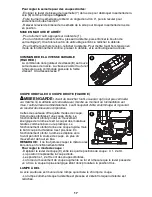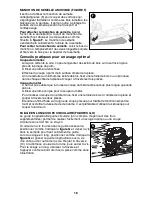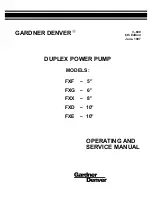
3
f)
Dress properly. Do not wear loose clothing or jewelry. Keep your hair, clothing and
gloves away from moving parts.
Loose clothes, jewelry or long hair can be caught in moving parts.
g)
If devices are provided for the connection of dust extraction and collection facilities,
ensure these are connected and properly used.
Use of dust collection can reduce dust-
related hazards.
4) POWER TOOL USE AND CARE
a)
Do not force the power tool. Use the correct power tool for your application.
The correct
power tool will do the job better and safer at the rate for which it was designed.
b)
Do not use the power tool if the switch does not turn it on and off.
Any power tool that
cannot be controlled with the switch is dangerous and must be repaired
.
c)
Disconnect the plug from the power source and/or the battery pack from the power
tool before making any adjustments, changing accessories, or storing power tools.
Such
preventive safety measures reduce the risk of starting the power tool accidentally.
d)
Store idle power tools out of the reach of children and do not allow persons unfamiliar
with the power tool or these instructions to operate the power tool.
Power tools are
dangerous in the hands of untrained users.
e)
Maintain power tools. Check for misalignment or binding of moving parts, breakage of parts
and any other condition that may affect the power tool’s operation. If damaged, have the power
tool repaired before use.
Many accidents are caused by poorly maintained power tools.
f)
Keep cutting tools sharp and clean.
Properly maintained cutting tools with sharp cutting
edges are less likely to bind and are easier to control.
g)
Use the power tool, accessories and tool bits, etc. in accordance with these instructions,
taking into account the working conditions and the work to be performed.
Use of the power tool
for operations different from those intended could result in a hazardous situation.
5)
SERVICE
a)
Have your power tool serviced by a qualified repair person using only identical replacement
parts.
This will ensure that the safety of the power tool is maintained.
SPECIFIC SAFETY RULES
•
Hold power tools by insulated gripping surfaces when performing an operation
where the cutting tool may contact hidden wiring or its own cord.
Contact with a
"live" wire will make exposed metal parts of the tool "live" and shock the operator.
•
Use clamps or another practical way to secure and support the work piece to a
stable platform.
Holding the work by hand or against your body leaves it unstable and
may lead to loss of control.
•
Keep hands away
from cutting area. Never reach underneath the material for any
reason. Hold front of saw by grasping the contoured gripping area. Do not insert fingers
or thumb into the vicinity of the reciprocating blade and blade clamp. Do not stabilize the
saw by gripping the shoe.
•
Keep blades sharp.
Dull blades may cause the saw to swerve or stall under
pressure.
•
When cutting pipe or conduit
ensure that they are free from water, electrical wiring,
etc.
•
Allow the motor to come to a complete stop before withdrawing the blade from
the kerf (the slot created by cutting).
A moving blade may impact the workpiece
causing a broken blade, workpiece damage or loss of control and possible personal
injury.
•
Never hold work in your hand, lap or against parts of your body when sawing.
The
saw may slip and the blade could contact the body causing injury.
•
Keep handles dry, clean, free from oil and grease.
This will enable better control of the
tool.
•
Clean out your tool often, especially after heavy use.
Dust and grit containing metal
particles often accumulate on interior surfaces and could create an electric shock hazard.
•
Do not operate this tool for long periods of time.
Vibration caused by the operating
action of this tool may cause permanent injury to fingers, hands, and arms. Use gloves to
provide extra cushion, take frequent rest periods, and limit daily time of use.
WARNING:
ALWAYS
use safety glasses. Everyday eyeglasses are NOT safety
glasses. Also use face or dust mask if drilling operation is dusty. ALWAYS WEAR
CERTIFIED SAFETY EQUIPMENT:




































